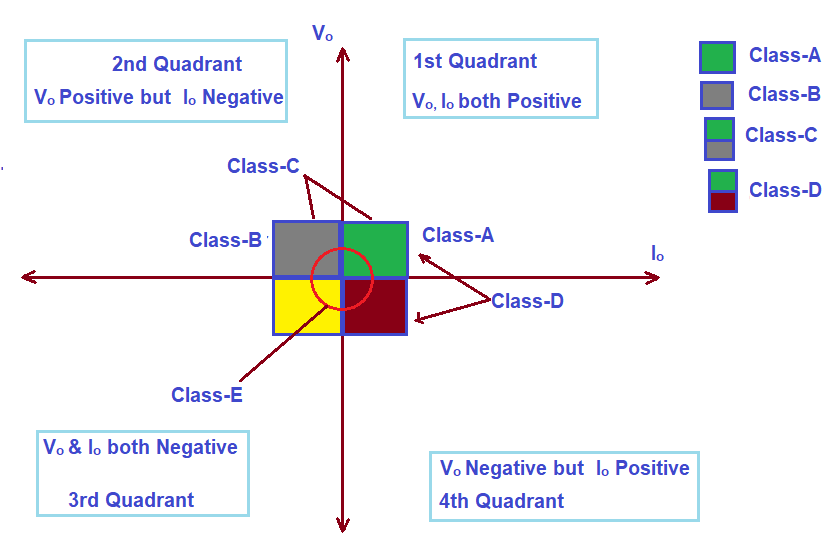There are mainly two types of chopper: Step-up and Step-down chopper. This classification is based on the average DC output voltage of chopper. However, on the basis of quadrant operation, a chopper may be classified into five different types: Class-A, Class-B, Class-C, Class-D and Class-E chopper. This article outlines the classification of chopper on the basis of average DC output voltage and quadrant operation.
Types of Chopper on the basis of Output Voltage:
A chopper is a semiconductor static device which converts fixed DC input voltage (Vs) to a variable DC output voltage (Vo). The average value of DC output of chopper may either be more than the source / fixed input voltage or less than source voltage. This forms the basis of classification. Here, note that it is the average value of output voltage as the output of chopper is not continuous rather it is discontinuous. Hence, average value is used for comparison with source voltage (Vs).
There are two types of chopper, namely, Step-up and Step-down chopper. This categorization of chopper on the basis of output voltage is shown below.

Step-up Chopper:
It is a kind of chopper in which the average DC output voltage is more than the source voltage. In this chopper, power flows from load to source and load contains a source of emf and should be inductive.
Step-down Chopper:
A chopper whose average DC output voltage is less than the source voltage is called step-down chopper. Power flows is always from source to load in this chopper.
Classification on the basis of Quadrant Operation:
Though chopper is a semiconductor static device, which essentially means that the direction of current flow is restricted through it. But chopper circuit can be so modified that operation of chopper is achieved in any of the four quadrants. This gives us a ground to classify the choppers. On the basis of quadrant operation, a there are five types of choppers: Class-A, Class-B, Class-C, Class-D and Class-E choppers. A pictorial categorization is shown in the figure below.

Class-A chopper can only operate in first quadrant. This means that, the load current and load voltage is always positive. Load current always flows from source to load and hence we can say that power is always transferred from source to load. Step-down chopper is an example of Class-A chopper.
The operation of Class-B chopper is confined in second quadrant. What does this mean? This means, though output voltage of chopper will be positive but the load current will be negative. Negative load current means, io flows from load to source. Thus, the power will always be transferred from load to source in this type of chopper. Step-up chopper is a Class-B chopper.
Class-C chopper can operate in both the first as well as second quadrant. During the first quadrant operation, it acts a step-down chopper while in second quadrant it behaves as step-up chopper. Basically, Class-C is obtained by parallelly connecting Class-A & Class-B chopper. This type of chopper is also known as Two Quadrant Class-A chopper. Refer the figure shown above for better understanding.
Class-D chopper is can operate in first and fourth quadrant. In this chopper, the direction of load current doesn’t reverse rather the average DC output voltage (Vo) may reverse. For in-depth understanding of how the polarity of output voltage reverses, kindly read Class-D chopper. Power can either be transferred from source to load or load to source. This chopper is also known as Two Quadrant Class-B chopper.
Class-E chopper is a universal chopper and can operate in all the four quadrants. Four choppers and four diodes are required to make the circuit of Class-E chopper. The necessary condition for this chopper is that load must be inductive. To obtain operation of this chopper in third and fourth quadrant, polarity of load emf is reversed. Kindly read Class-E chopper for full concept of this chopper and its operation.
I learned a lot her thanks
It’s my pleasure.